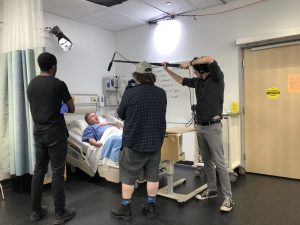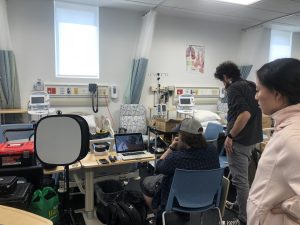Preparation, Rehearsals and Filming
The type of actor you hire will structure the preparation, rehearsals/dry runs, and filming of the virtual gaming simulation. Professional actors require less time to prepare and film each scene, whereas individuals who volunteer or are new to acting will require more time. Managing your time efficiently will assist in creating a quality virtual simulation, complete the simulation within your time frame, and optimize your budget.
Preparation
Preparing the actors for the production phase is an important component in the virtual gaming simulation development process. Preparation should start during the initial discussion of the simulation and be introduced to the actors during the interview phase.
Creating a realistic timeline to share with the actors encourages discussion, supports transparency, and ensures all team members can commit to the schedule and their role during filming. The actors need time to immerse themselves into their role and prepare the lines. The length of the script, the complexity of the scenes (e.g., language, actions), and the number of scenes need to be taken into consideration when creating the timeline.
Psychological Safety
Acting requires the actor to become vulnerable in a role to express emotions that portray a client’s lived experience. Being in this vulnerable position requires a safe, collaborative environment. A clear and thorough preparation can help foster a psychological safe environment. The following are some key components you can include in your preparations with actors related to their role in the virtual simulation:
- Introduction of all team members involved and their role in the team. During the introduction, share the importance of creating a safe environment by opening the discussions and sharing expectations and objectives of virtual gaming simulation.
- Present clear directions regarding who the actors should contact about their role and potential questions or concerns. For example, with contracts, location of filming, requirements for the role.
- Provide clear instructions regarding the role, character backstory, timeline required for filming (e.g., rehearsals, filming, post-production), film dates and time, and filming location (e.g., address, available parking and food/beverages/kitchen on site)
- Explain how the videos/images will be used (e.g., virtual simulation, open access, website).
- Review the script together with all of the actors. Answer questions throughout to encourage open dialogue, address biases/assumptions, provide constructive feedback,
- Discuss any sensitive topics within the script to determine the actors’ comfort level, potential past experiences or trauma and need for further explanations regarding how the scene should be enacted.
- Orientation to the filming locations.
- Provide extra training for non-trained actors because they can feel vulnerable in roles.
- Provide extra training/explanation/demonstrations for actors without a medical language/background knowledge as needed.
- Debrief as a team after each filming day and have counselling/support resources available as needed.
Insights from the Student Team
Nursing student Starr Ferguson shared their experience acting the role of the client in the An Interprofessional Virtual Gaming Simulation: Breaking the Chain of Transmission
“As a novice actor, it was exciting to work alongside professional actors. During rehearsals, the actors were very encouraging, and they shared with me tips and tricks on memorizing lines, and they told me to just have fun with it! It was a great experience filming with Jan [who played the role of the nurse] because we were able to bounce ideas off each other, which made the acting in the scenes flow smoother during filming. Also, by playing the role of Nina, I have gained more insight on the perspective of a client, which will inform my interventions in providing care and health teaching. Overall, it was a positive experience as this was my first acting role, and I was very glad to be a part of a great team!”
Creating the Character Backstory for the Actors
Creating a thorough and clear character backstory for the actors will help them to prepare for their role and clarify any aspects of the character or wording in the script that is unclear. As an expert in the field, you will need to explain various terminology that will be used in the virtual simulation and how the actor will need to behave/act for the various medical conditions.
For example, if the actor is playing a healthcare professional (e.g., nurse) in a crisis, the nurse’s vocal tone should be clear and direct when stating orders. If the actor portrays anger or being timid with a low voice, it will not be realistic to a nurse in a real-life crisis in the hospital. Or if the nurse provides a report to another nurse, the use of medical terminology should be pronounced correctly. You can include various components to help develop your characters’ backstory.
A Character Backstory Guide for Actors
- Include characteristics of client role — age, visual appearance, knowledge level (e.g., diagnosis, current situation, care being provided, overall health, communication).
- Medical history.
- Physical examination findings, including the signs and symptoms and how to portray the findings at the various points in the script. For example, in some virtual simulations, the client’s health will deteriorate, therefore, their physical and cognitive behaviour may change.
- Social history to enhance the relational aspect of the client.
- Environment where the virtual simulation scenario takes place: hospital, clinic, person’s home, office. Include in the description other people who will be involved in the scene: family, care partner, interprofessional team members.
- Outline what the actors will need to wear in the various scenes (e.g., street clothes, hospital gown, prosthetics, moulage).
- Identify if the scene will have medical equipment attached to the client or used on or by the actor (e.g., blood pressure cuff, dressing, spirometer, oxygen mask).
- Explain when and how the actor’s body will be exposed in the scene (e.g., exposing the back or abdomen during auscultation).
All of these key pieces will help the actor to prepare for filming and begin to immerse into the client’s role.
Listen to Melanie Forchetti’s discussion about setting the scene and how to write character breakdowns:
Here’s a sample of a character breakdown created for our Virtual Gaming Simulation (VGS) Model – Character Breakdown.
Rehearsal
The rehearsal, also known as a dry run, involves walking through the script and scenes together as a team. It can involve rehearsing the lines, as well as the actions performed in each scene. Dry runs can help you get a sense of how the scene will feel, it will help to set up for filming (e.g., angles, lighting), identify potential challenging areas, discover aspects of the script that may be unclear, and provide a holistic understanding of how the scenes will unfold and come together.
Send the actors a copy of the script ahead of the rehearsal date — ideally 2–3 weeks for them to review the script, write down or email questions, clarify sections, and begin to practice their role. When providing the script to the actors, it is important to explain how to read the script because your format of the script may be different from what the actors have received in the past for other roles.
If you are new to script writing, this can be a good opportunity to collaborate with the actors and ask them about their overall perspective on the script. The actors’ insight and experience originate from a different educational background and pedagogy, and can therefore enhance the overall virtual simulation quality and realism — for example, with the use of language. Is the language in the script structured similar to a lecture, or is it more natural and authentic? A good virtual simulation script is educational, yet realistic and tangible to simulate a real clinical environment.
When the actors rehearse for the virtual simulation, it provides a good opportunity for them to ask questions, clarify their perceptions of the scene, and collaborate with you on the team’s vision. Actors can begin to learn from each other and play off of each other’s cues. During the rehearsal, the actors will be able to teach one another about their practice, including how they incorporate emotions, physical movement, body language, and tone into the scene.
At the beginning and end of rehearsal, review the logistics of the rehearsal and filming day. For example, orientation of the film location, agenda, time to arrive on set, where they can prepare lines prior to filming, where they can change (if needed), and rules while on set. After the rehearsal, it is good to debrief the day, answer questions and prepare for filming.
An Actor’s Reflections
“The opportunity to participate in a dry run rehearsal day was invaluable to the successful understanding of my character and his personality in the nurse/patient paradigm. Practicing and learning my lines on my own (or with  helpers at home) was a good first step in acting this character, but was ultimately insufficient to fully understand the dynamic between the characters as they navigated each scene together. The dry run day provided the opportunity to look into the face of the other actors and see their interaction with me as we worked through the script. It allowed me to engage in a real-world interaction with the other actor/character to provide a more complete understanding of the dynamic between our characters as well as clarify the directors’ vision for the mood of each scene.”
helpers at home) was a good first step in acting this character, but was ultimately insufficient to fully understand the dynamic between the characters as they navigated each scene together. The dry run day provided the opportunity to look into the face of the other actors and see their interaction with me as we worked through the script. It allowed me to engage in a real-world interaction with the other actor/character to provide a more complete understanding of the dynamic between our characters as well as clarify the directors’ vision for the mood of each scene.”
Garrick Meyers, actor for COPD Virtual Gaming Simulation
Filming Day
As actors arrive on the first day, orient them to the location where to leave their personal belongings, the dressing room location, and the practice area where they can review their lines as the filming crew begins to set up the environment. Review that day’s agenda and outline the goals for that film day. Agenda items may include which scenes will be filmed that day, break times, time to arrive on set for their scene, debrief, and preparation for the following day.
Prior to filming, it is essential to review the rules while on set. For example, there should be complete silence on set when filming, the use of the clap board, importance of following the project lead’s direction, talking one at a time to ensure everyone’s voice is heard, allowing a pause before and after each scene for editing.
At the end of each filming day, it is good to debrief the day. It does not have to be a structured debrief and can instead be informal. You can ask everyone what they think went well, what their goals are for the next filming day, and if they have any questions. As filming occurs, sometimes scenes may change and be revised on set. If that occurs, email the review script to the actors, so they are ready the by following day.


Now that the actors and you are ready, let’s learn about filming, audio, editing and post-production in Chapter 4!

